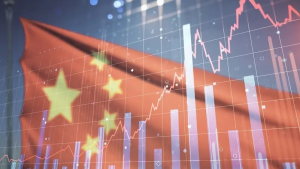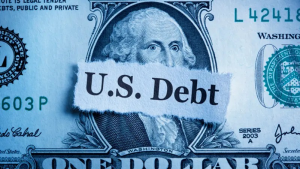U.S. stocks edged lower on Friday as traders reacted to new economic data signaling slowing inflation and better-than-expected consumer sentiment.
The S&P 500 fell 0.41% to close at 5,460.48, and the Nasdaq Composite dropped 0.71% to 17,732.60. Both indexes hit new intraday highs earlier in the session before retreating. The Dow Jones Industrial Average dipped 45.20 points, or 0.12%, ending at 39,118.86.
All three major indexes advanced in June, marking their seventh positive month in eight. The Nasdaq led with a nearly 6% monthly gain, while the S&P 500 and Dow rose 3.5% and 1.1%, respectively. For the week, the Nasdaq added 0.2%, while the S&P 500 and Dow edged down by less than 0.1%.
May inflation slowed to its lowest annual rate in over three years, according to the Commerce Department. The core personal consumption expenditures (PCE) price index, excluding food and energy, rose 0.1% for the month and 2.6% year-over-year, matching Dow Jones estimates. The core PCE is the Federal Reserve’s preferred inflation measure.
The headline PCE, including food and energy, remained flat month-over-month and increased 2.6% annually, also meeting expectations.
With the Q1 2024 earnings season wrapped up, the market’s attention this week will mainly center on upcoming economic data releases, most notably the ISM manufacturing index on Monday, the JOLTS job openings report on Tuesday, and the nonfarm payrolls (NFP) report on Friday. Moreover, the minutes from the June FOMC meeting will be published on Wednesday.
For Friday’s employment report, Goldman Sachs economists expect that non-farm payrolls rose by 140,000 in June.
“Big Data measures continue to indicate a below-normal pace of job creation during the spring hiring season, and our layoff tracker is also edging higher from low levels,” they said in a note.
“We also assume a 50k drag from payback effects, because the longer-than-usual May payroll month likely pulled forward reported job growth into last month’s report.”
Economists also project that the unemployment rate remained unchanged at 4%, reflecting rising household employment offsetting a 0.1 percentage point rebound in labor force participation to 62.6%.
In addition, there are several speaking engagements from Federal Reserve officials scheduled for this week, including Fed Chair Powell on Tuesday and New York Fed President Williams on Wednesday and Friday.
BofA: S&P 500 poised for a strong second half after positive 1H Bank of America strategists forecast a strong second half for the S&P 500 (SPX) following a positive first half of 2024.
The benchmark equity index rose 14.48% in the first half, marking the 16th-best first-half performance since 1928. Historically, when the index rallies in the first six months, it tends to perform well in the latter half, being up 74% of the time with average and median returns of 5.70% and 6.56%, respectively.
The first half of 2024 marks the 26th time the SPX has gained between 10% and 20% in the initial six months. This pattern suggests a positive outlook, with the index historically rising 88% of the time in the second half, averaging a return of 8.58% and a median return of 10.13%.
In Presidential election years, a strong first half further boosts the SPX's prospects for the latter half, with an 88% chance of gains, BofA highlighted. However, the expected average and median returns are slightly lower at 6.98% and 5.47%, respectively.
Overall, during the last six months of all Presidential election years since 1928, the SPX has risen 83% of the time, with average returns of 7.26% and median returns of 6.12%.
"When the SPX rallies over the first six months of the year, the index is stronger over the rest of the year and is up 74% of the time on average," BofA strategists said in a note.
What analysts are saying about US stocks BTIG: “As we enter the second half of the year, we are left with more questions than answers. Namely the breadth expansion that was occurring in late '23 fizzled out and was never able to find its footing despite cooling inflation and lower long-term rates. The equal-weight S&P 500 (SPW) has underperformed the SPX by nearly 10% over the first six months, one of the worst such stretches on record back to 1990 and by far the worst 'first six months' of the year. If small-caps are going to work, we think they have to start soon or they become the 'canary in the coalmine' rather than a rotation opportunity. At this point small-cap growth (IWO) looks better than value, but it's still in a 'show me' state.”
Wedbush: “We believe NASDAQ has another strong 2H ahead as tech stocks will be up 15% the rest of 2024 in our view with tech fundamentals set to accelerate as AI use cases materially expand. On the enterprise AI front Nvidia/Microsoft will drive this while Apple/Meta/Google now unleash the consumer AI Revolution heading into year-end with iPhone 16 the beginning of this AI driven smartphone era. The Godfather of AI Jensen and Nvidia (NASDAQ:NVDA) have been the stars of the AI Party on the disco dance floor along with Nadella and Microsoft (NASDAQ:MSFT) as the enterprise AI tidal wave of spending has just begun with the Street now laser focused on who the winners are in this next wave of AI driven spend. Looking into 2H24 we believe a massive broader tech rally is ahead as the AI Revolution now accelerates.
Goldman Sachs: “The first presidential debate shifted prediction market probabilities in favor of an Trump victory. The debate window generally saw modest upward moves in US equities and bond yields and mixed performance across FX. Shifts in asset prices were small relative to the shifts in election outcome probabilities.
“Equity and bond shifts were comparable to our fundamental estimates, but we ultimately expect clearer and broader USD strength from a shift towards a Republican presidency than what we saw in FX markets.”
Deutsche Bank: “As we noted last week, we see conditions in place for an equity market breather in the near term with diminished support from all three elements of our demand-supply framework: there is little room for positioning to rise after a sharp but narrow jump to elevated levels; inflows are likely to ease as risk appetite declines from stretched levels; and buybacks diminish temporarily as blackout periods ramp up. This suggests a sideways market in the near term, but one that is vulnerable to negative shocks with plenty of potential catalysts geopolitically as well as in domestic politics.”













